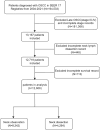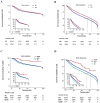Neck dissection improves the prognosis of patients with early-stage oral squamous cell carcinoma
- PMID: 40185843
- PMCID: PMC11971466
- DOI: 10.1038/s41598-025-96018-2
Neck dissection improves the prognosis of patients with early-stage oral squamous cell carcinoma
Abstract
For early-stage oral squamous cell carcinoma (OSCC), the primary treatment modality generally entails surgical resection. However, the role of neck dissection in early-stage OSCC remains controversial. The aim of this study was to evaluate the effect of neck dissection on the prognosis of patients with early-stage OSCC. We identified patients with early-stage OSCC from the Surveillance, Epidemiology, and End Results database spanning from 2004 to 2021. We collected demographic and clinical data, including age, sex, tumor site, marital status, race, residence, income, grade, records of radiotherapy and chemotherapy, neck management modality, survival time, disease-specific survival (DSS), and overall survival (OS). A retrospective cohort study design was employed to differentiate between the neck observation and neck dissection group. Kaplan-Meier survival analysis and Cox regression were utilized to evaluate the association between neck dissection and survival outcome. The study included 12,606 patients, of whom 5135 died (available for OS analysis), and 2477 died from OSCC (available for DSS analysis). Kaplan-Meier survival analysis revealed statistically differences between the observation and neck dissection group in OS (p < 0.0001) and DSS (p = 0.00067). Multivariate analysis confirmed that neck dissection was associated with improved survival, after adjusting for multiple factors such as, age, sex, tumor site, marital status, race, residence, income, grade, records of radiotherapy and chemotherapy, neck dissection was associated with a decreased risk of both DSS (hazard ratio [HR] = 0.73, 95% confidence interval [CI] = 0.66-0.8; p < 0.001) and OS (HR = 0.76, 95% CI = 0.71-0.81; p < 0.001). Patients with early-stage OSCC may derive significant clinical benefit from neck dissection; therefore, neck dissection is recommended for such patients.
Keywords: Disease-specific survival; Early-stage; Oral squamous cell carcinoma (OSCC); Overall survival; neck dissection; neck observation.
© 2025. The Author(s).
Conflict of interest statement
Declarations. Competing interests: The authors declare no competing interests.
Figures



Similar articles
-
Elective neck dissection improves the survival of patients with T2N0M0 oral squamous cell carcinoma: a study of the SEER database.BMC Cancer. 2021 Dec 7;21(1):1309. doi: 10.1186/s12885-021-09053-3. BMC Cancer. 2021. PMID: 34876079 Free PMC article.
-
Perineural invasion in T1 oral squamous cell carcinoma indicates the need for aggressive elective neck dissection.Am J Surg Pathol. 2013 Aug;37(8):1164-72. doi: 10.1097/PAS.0b013e318285f684. Am J Surg Pathol. 2013. PMID: 23681077
-
Do patients with cN0 oral squamous cell carcinoma benefit from elective neck dissection? A large-scale population-based study.BMC Oral Health. 2024 Jan 6;24(1):32. doi: 10.1186/s12903-023-03632-5. BMC Oral Health. 2024. PMID: 38184544 Free PMC article.
-
The relevance of surgical margins in clinically early oral squamous cell carcinoma.Oral Oncol. 2020 Nov;110:104913. doi: 10.1016/j.oraloncology.2020.104913. Epub 2020 Jul 22. Oral Oncol. 2020. PMID: 32711167
-
Elective neck dissection versus observation for early-stage oral squamous cell carcinoma: Systematic review and meta-analysis.Oral Oncol. 2020 Jun;105:104661. doi: 10.1016/j.oraloncology.2020.104661. Epub 2020 Mar 31. Oral Oncol. 2020. PMID: 32244173
References
-
- Wang, S. et al. Metal polyphenol nanoparticle-based chemo/ferroptosis synergistic therapy for the treatment of oral squamous cell carcinoma. Bioconjugate Chem.35(11), 1835–1842. 10.1021/acs.bioconjchem.4c00462 (2024). - PubMed
-
- Li, Q. et al. Disparities in 36 cancers across 185 countries: Secondary analysis of global cancer statistics. Front. Med.18(5), 911–920. 10.1007/s11684-024-1058-6 (2024). - PubMed
-
- Shah, H. P. et al. identifying opportunities to deliver high-quality cancer care across a health system: A clinical responsibility. Otolaryngol. Head Neck Surg.171(2), 445–456. 10.1002/ohn.755 (2024). - PubMed
-
- Liao, C. T. et al. Identification of a high-risk subgroup of patients with resected pT3 oral cavity cancer in need of postoperative adjuvant therapy. Ann. Surg. Oncol.18, 2569–2578. 10.1245/s10434-011-1616-4 (2011). - PubMed
MeSH terms
Grants and funding
LinkOut - more resources
Full Text Sources
Medical

